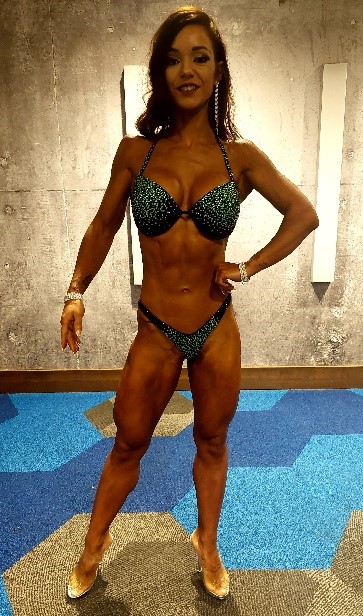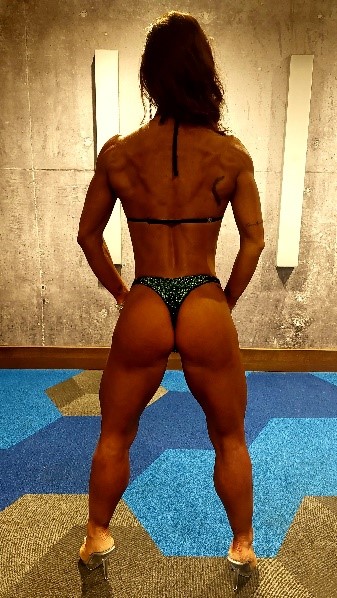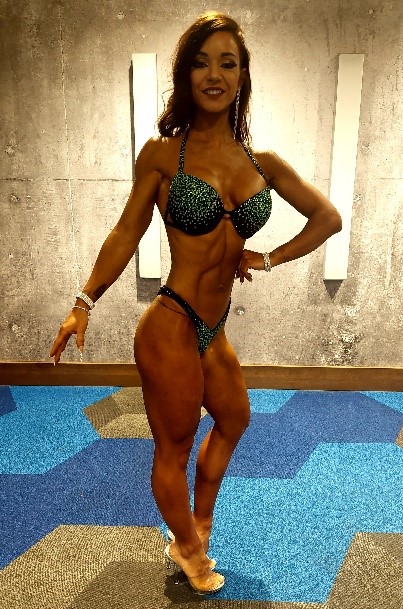Competitor Rules
The ANBF Wellness category is for females with an athletic physique wishing to showcase more body mass in the glutes, thighs, hips, and calves. This is the only asymmetrical category in the ANBF. Although the upper body will be developed, it will not match the level of development of the lower body.
Wellness competitors will be judged in two-piece suits and clear high heels. Suits may be of any color, pattern, and style. Straps should NOT be crisscrossed and hooked into the suit bottoms. Suits should be in good taste; no thongs/T-back bottoms will be permitted. ANBF promoters reserve the right to disqualify a competitor from competing in a specific show if their suit is deemed inappropriate. Jewelry and hair adornment will be allowed during all rounds of judging.
Classes will be determined after check in.
Judging Criteria
Judges will evaluate Wellness competitors on the following criteria:
Posing/Presentation – Posing/Presentation score is a measurement of how well the competitor presents herself and displays their physique on stage as well as adherence to ANBF posing guidelines. Competitors should present themselves with poise, good posture and confidence and should utilize posing that enhances their physique (i.e. no overly pointed elbows, arms too far from midline of body, and lats will not be flared in the Wellness division. Competitors should be able to transition between poses quickly and smoothly. Other factors that can affect overall presentation score are hair, makeup, skin tone, complexion and suit fit.
Symmetry – Symmetry score is a measurement of the evenness of development of the competitor’s physique and how well the parts of the physique flow together. The Wellness category will purposely lack symmetry regarding the lower and upper body. The lower body will have more body mass than the upper body. Wellness will include the balance and proportion of the competitor from side to side, BUT NOT top to bottom. The lower body muscle groups will clearly stand out from the rest.
Muscularity – Muscularity refers to muscle size and development relative to the competitor’s frame, including shape and size. The level of muscularity is determined by the extent of development in relation to the size of the competitor’s skeletal structure. Also, to be considered is the shape and contour of the developed muscle and muscle groups.
Wellness competitors should display:
- A slight level of muscularity.
- Full/round shoulder caps that are slightly more developed than Bikini BUT less than Figure with no visible striations
- Visible quad development; Athletic appearance with slight separation with no striations. Not as lean and defined as Figure or Women’s Physique.
- Visible hamstring development.
- Full, round, firm glutes, with a slight separation between the hamstring and glute area but no striations. The glutes will be bigger than current ANBF Bikini competitors. They will not be as lean and defined as Figure or Women’s Physique.
- Slightly more muscle than a Bikini competitor; The lower body muscle size will clearly stand out from the upper body muscle size.
Conditioning – Conditioning refers to the level of differentiation between adjacent muscles delineating sections or fibers within the same muscle group and the degree of firmness (hardness) of muscle tone. Leanness is important but an overly dieted appearance is neither advantageous nor desirable. The Wellness category will have similar conditioning as the Bikini category. However, Wellness athletes will have slightly more muscle.
Wellness competitors should display:
- Overall healthy and fit muscle tone.
- Visible abdominal definition.
- Visible quad definition.
- Visible hamstring definition.
- Full, round, firm glutes with visible tie-in to hamstrings
- Should NOTdisplay deep cuts, striations, or overly dieted look.
- Should NOTdisplay deeply drawn-in faces or stringy-looking muscularity (an emaciated look).
Group Comparisons
After the individual presentation for each competitor are complete, the class is brought to front center stage and is guided through quarter turns to display physiques from the front, left, back, and right. Quarter turn transitions should be fluid with no stiff, jerky, military-style, or overly suggestive movements.
Front Stance – Both feet should remain in alignment on the designated line on the stage (i.e., no staggered stance). Both feet should be pointed in a frontward direction. Competitors will face the front and place on hand on their hip. The other arm will hang down relaxed with the same side leg slightly extended to the side. Competitors are not allowed to bend the free hanging arm at the elbow and wrist (teacup), such as seen in Bikini competitors. Hip can be slightly twisted to the side.
(Quarter Turn Right) Left Side Stance – Competitors will stand slightly turned towards the judges. Both feet should be pointing towards the side of the stage they are turned to. Their right hand will be placed on the hip. The left arm will hang down relaxed at the side. The right leg will be bent at the knee. This will appear like a twisted Bikini side pose. Competitors are not allowed to bend the free hanging arm at the elbow and wrist (teacup), such as seen in Bikini competitors.
(Quarter Turn Right) Rear Stance – Both feet should remain in alignment on the designated line on the stage (i.e., no staggered stance). Competitors will arch their lower backs and push their glutes back. Competitors are not allowed to bend the free hanging arm at the elbow and wrist (teacup), such as seen in Bikini competitors.
(Quarter Turn Right) Right Side Stance – Competitors will stand slightly turned towards the judges. Both feet should be pointing towards the side of the stage they are turned to. Their left hand will be placed on the hip. The right arm will hang down relaxed at the side. The left leg will be bent at the knee. This will appear like a twisted Bikini side pose. Competitors are not allowed to bend the free hanging arm at the elbow and wrist (teacup), such as seen in Bikini competitors.
Note: Competitors, who are overly suggestive, bent over in their rear stance or not following other ANBF posing guidelines may, at the discretion of the head judge, be corrected. If the competitor fails to adjust when corrected, then judges are instructed to address this in their scoring. Failure to comply with ANBF posing guidelines will result in a lower placement in the presentation/posing round. This applies to group comparisons as well as individual stage walks.
Individual Presentation Stage Walk
The presentation portion will immediately follow group comparisons for the class. After a class files off, the first person in the class will return to the stage to perform their individual stage walk. The stage walk will consist of the following: walk to center stage and perform two poses of the competitor’s choice, then proceed to the same side of the stage they entered from and display two poses of their choice, then proceed to the opposite side of the stage where they will perform two poses of their choice. To complete the walk, the competitor will return to center stage and perform a final pose and wave/curtsy before exiting the stage.
Individual presentations should be done tastefully and be conducive to a family atmosphere.




